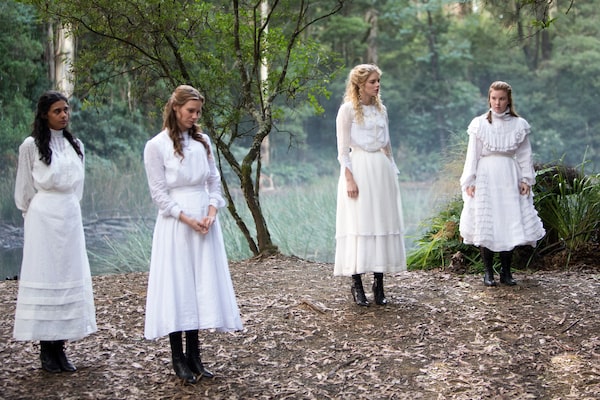
Picnic at Hanging Rock explores the young women in depth, dramatizing their inner rage at being restricted and told to conform.
Peter Weir’s 1975 film version of Picnic at Hanging Rock is famous for its soft-focus, gauzy beauty and the chill in the unexplained key event – in Australia on Valentine’s Day, 1900, three young women and a teacher from a boarding school disappear while on an outing to Hanging Rock, a former volcano. It is also notable for its subtly suggested menace – a menace that is really Victorian sexual repression. Mind you, today the subtlety looks less suggestive and more attenuated.
Today is what matters, when it comes to grappling with the mystery that is the story. The perspective of today’s world.
Picnic at Hanging Rock (Sunday, Bravo, 10 p.m.) is a new six-part series based on the same source material, a 1967 novel by Joan Lindsay. What drives and makes the show more unsettling than the film is its contemporary approach to female characters. We are not in the 1960s or 1970s here. We are in a time when the core of women characters is not treated as a remote thing. This version is not remote from the main characters at all.
Why Larysa Kondracki put women first on the set of TV mini-series Picnic at Hanging Rock
For a start, the founder and headmistress of the school, Hester Appleyard (Natalie Dormer from Game Of Thrones) is given much more heft right from the get-go. She is younger, and clearly much more treacherous and troubled. We see her in widow attire, sourly traipsing the mansion that will become her school. She won’t answer questions about her wealth or background. But we hear her inner voice, sneering at the false respectability of the rich.
Jumping forward, she’s running the school. A passel of the daughters of the well-off are her charges and she is trying to mould them into something. Exactly what is unclear. “You have abandoned restraint. You lack refinement,” she admonishes Miranda (Lily Sullivan), a teenage girl who is the most unsettling figure in the drama. A natural leader and tough, she is strikingly comely and aware of it, but somehow angry about it too. When she briskly sticks a pitchfork into the foot of a man that is bothering her, the calmness is unnerving.
Miranda and her small group of friends – most of whom are part of the disappeared group – seem to dislike both boys and men. Certainly they can terrify both. Miranda seems more at ease on a horse, or with her hand implanted into the mud. And when she does those things, something in her is lit on fire. The others who disappear are also misfits: the heiress Irma (Samara Weaving), the “bastard child” Marion (Madeleine Madden) and teacher Greta (Anna McGahan). Teacher Greta in particular seems to be forcing herself with great effort to be teacher-like.
“Maladies flourish in the dark,” says Mrs. Appleyard to one her younger students, with sinister intent. It’s a cryptic reference to something, probably some element of her own past. But what unfolds in the series is very much in the light, especially the picnic scene itself. There is a luminous quality to it – the white dresses in the strong sunlight and against the verdant green of the landscape.
It is what happens after the picnic scene that gives the series what the movie lacks. It explores the young women in depth, dramatizing their inner rage at being restricted and told to conform. It shows the pleasure they take in working together. Yes, there is an element of the Victorian repressed sexual hothouse here, but the show is far more interested in what the women find pleasurable in the ordinariness of female companionship and peer support. It is the community that goes slightly mental, really, not these young women.
There are times too when director Larysa Kondracki and writers Beatrix Christian and Alice Addison reach for a Twin Peaks quality: Scenes are shot from odd angles, dream sequences seem to end, but don’t. While the film version posits an inhibited erotic dynamic as the engine driving the drama, this mini-series tells us these women, from Hester Appleyard to the young disappeared, are unknowable.
It’s an intriguing mystery, all if it. And Picnic at Hanging Rock isn’t aiming to explain, only to make you look at its loveliness and be both awed and alarmed.